Abstract
The aim and contribution of this paper is to identify with Duval Pentagon 2 the stray gassing (SG) patterns of inhibited and uninhibited mineral oils in transformers in service and in the well-established laboratory SG tests of CIGRE and ASTM, so that SG in transformers can be easily distinguished from the other types of faults occurring in them. The SG test of IEC 60296-2020 is inadequate or much less effective for that purpose.
1. Introduction
Most large power transformers in service worldwide contain mineral insulating oils. About half of them are uninhibited [1], with a tendency to use more and more inhibited oils [2]. Only a tiny minority contain non-mineral (e.g., vegetable) oils.
The belief in the UK in the 1960s was that inhibited mineral oils were “low-quality oils” masked by the addition of an inhibitor and therefore that uninhibited mineral oils were more appropriate. However, this has been proven wrong by the fact that inhibited mineral oils have been used successfully during several decades in North America in transformers of all types.
All oils tend to produce “stray gases” in service, in various amounts and patterns depending on the oil used. Stray gassing (SG) of oil has been defined by CIGRE [3] as “the formation of gases in electrical insulating oils heated at relatively low temperatures of 90 to 200 °C”. SG is due to the chemical instability of oil molecules after they have been submitted to refining procedures, such as for example hydrogen treatment to remove impurities and undesirable chemical structures in mineral oils. Such treatments may oversaturate the hydrocarbon chains of mineral oil with hydrogen, which is then released as H2 gas, together with some C2H6 and CH4, when the oil is heated at various SG temperatures, or is in contact with oxygen [4].
H2 gas formed by SG is often mistakenly attributed to corona partial discharges (PD) in the transformers, sending false fault alarms to maintenance engineers. The aim and contribution of this paper is to avoid such misinterpretations, by identifying with Duval Pentagon 2 the SG patterns of the two main types of mineral oils used in transformers and in the well-established laboratory SG tests of CIGRE and ASTM, so that SG in transformers can be easily distinguished from the other types of faults occurring in them.
Duval Pentagon 2 is a graphical method used in the new CIGRE and IEEE Gas Guides [4,5] for the interpretation of dissolved gas analysis (DGA) in transformers. Pentagon 2 allows to precisely and easily identify visually the gas formation patterns occurring in the transformers in service and the types of faults that produced these gas patterns, i.e., electrical and thermal faults, corona partial discharges (PD), low energy arcing (D1), high energy arcing (D2), high temperature faults in oil only (T3-H), possible carbonization of paper (C), overheating (O) and stray gassing of oil (S).
This paper is a “research” paper containing original experimental data developed at the High Voltage Testing and Engineering Commission of Switzerland (FKH), comparing the stray gassing (SG) of inhibited and uninhibited oils during SG tests in the laboratory and in transformers of the FKH, as well as unpublished data discussed in CIGRE/IEC working groups in the past 10 years but not published nor reported anywhere. The conclusions arrived at in this paper also have never been discussed nor presented anywhere before.
2. Material and Methods
The database of dissolved gas analysis (DGA) of the High Voltage Testing and Engineering Commission of Switzerland (FKH) was used to identify the transformers of the FKH filled with inhibited mineral oil A (Nynas 4000X) or uninhibited oil B (Nynas Taurus) and producing gases of the SG type. Samples of oils A and B taken from the transformers were subjected to stray gassing tests in the laboratory of the FKH, using two different procedures:
(1) SG Procedure 1, developed by CIGRE in 2002 and published in 2006 [3], consisting of heating the oil in a syringe in an oven at a temperature of 120 °C during 164 h. This procedure can also be used at other temperatures (between 70 and 160 °C) and during different periods of time (from 24 h to >164 h). Different SG temperatures and periods of time were indeed used in this paper to determine the influence of these two factors on the SG patterns during the SG tests, as illustrated in Figures 1, 3, 5, 7 and 8. The same procedure, but at 120 °C, 164 h only, was used in the ASTM Standard Test Method D7150, first published in 2005 [6].
(2) SG Procedure 2, described in the new IEC Standard 60296-2020 [7], consisting of heating the oil at 105 °C during 48 h, with or without a piece of copper foil inserted in the syringe. This procedure was developed in 2004 by Donald Hepburn at the Glasgow Caledonian University, for National Grid Transco UK, but has not been used elsewhere.
Gases formed in oil during the SG tests at the FKH were analyzed by its DGA laboratory and plotted in Duval Pentagon 2 [8] for easier comparison of the results. Gases formed during these SG laboratory tests were then compared to those formed in zones S and O of Pentagon 2 in the FKH transformers filled with oils A or B.
The same was done for the SG results reported by sources other than the FKH during laboratory tests and in transformers in service. The identity of these other laboratories and transformer owners cannot be disclosed publicly, only on a confidential basis through a special request to the authors and are thus represented by an anonymous reference number in the Figures of this paper (e.g., ref. 1 to ref. 6 in Figure 3). Around 15 laboratories and owners of transformers other than the FKH are mentioned in Figures 3, 4, 7–10, from 12 different countries. Most of them are highly respected laboratories, strictly following the SG test and DGA standard procedures, so their results can be considered as very accurate and reliable. All of them indicated the type of oil used (inhibited or uninhibited), but rarely the commercial brand of oil. Their SG tests were performed on the same oil used in their transformers. The age of their transformers and oils in general was not mentioned.
From the results examined in this paper, the main factors influencing SG patterns are the SG temperature and the type of oil used (inhibited or uninhibited). No data were available suggesting that the age of the transformers and oils may influence the SG patterns.
3. Stray Gassing of Inhibited Mineral Oil A
When the testing inhibited mineral oil A at the FKH with Procedure 2 at 10 °C during 48 h, with or without copper, only very small amounts of gas were formed (below 2 ppm), too small to reliably identify the SG patterns of inhibited oil A.
This is possible using Procedure 1 because of the longer test duration (164 h) and/or the higher temperature (120 °C) used. The SG patterns of inhibited oil A using Procedure 1 during 164 h are indicated in Figure 1. SG at 105 °C and at 120 °C, with and without copper, occurs in the same small region (“Cluster 1”) of zone S and at 160 °C in Cluster 2. The same term of “cluster” will be used throughout the following text to indicate a small specific region of Pentagon 2.
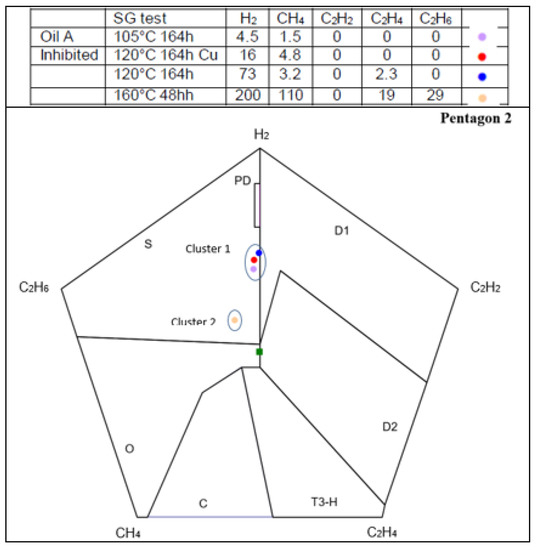
Figure 1.
Stray gassing (SG) of inhibited mineral oil A during laboratory tests at the High Voltage Testing and Engineering Commission of Switzerland (FKH), in Clusters 1 and 2.
It can be seen in Figure 1 that copper does not affect the SG pattern of inhibited oil A (at 120 °C it is similar with and without copper). However, copper unexpectedly reduces the amount of H2 formed, so it behaves as an inhibitor of SG formation.
This means that SG gas formation in the inhibited mineral oils is not related to oxidation, otherwise it would be enhanced by the copper, but rather to thermal degradation only. The reason why it is inhibited by copper would require further investigations outside the scope of this paper.
From these SG laboratory test results with inhibited oil A, it can be concluded that (1) SG Procedure 2 is not appropriate for identifying the SG patterns of the inhibited mineral oils, because not enough gases are formed, with or without copper; (2) SG Procedure 1 is much more appropriate—it produces amounts of gas large enough to identify SG patterns; (3) copper does not affect the SG patterns; and (4) copper, however, markedly reduces the amount of gases in the ppm formed by SG—so, transformers filled with inhibited mineral oil will produce less gases if they are built with bare copper wires rather than with enameled ones.
The typical SG patterns observed in a transformer of the FKH filled with oil A are indicated in Figure 2. They tend to occur in Clusters 1 and 2, almost exactly as during the laboratory SG tests. Therefore, they were probably due to local overheating of the oil at ~120 °C and ~160 °C, respectively, almost impossible to detect with electrical and acoustic tests and by visual inspection.
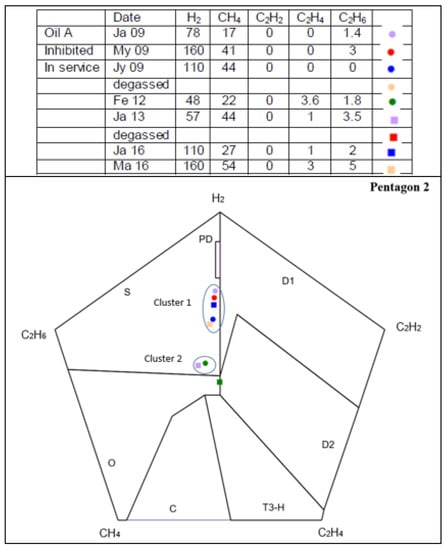
Figure 2.
SG of inhibited mineral oil A in a transformer of the FKH, in Clusters 1 and 2.
The amounts of gas formed in the transformer are higher than during the laboratory SG tests, probably because the oil was overheated during years in service, not only after 164 h.
This transformer had bare copper wires. Had the enameled copper be used, H2 levels probably would have been higher.
Corona Partial Discharge (PD) tests made on these transformers did not detect any corona PD activity, so gas formation was due only to SG of the oil.
4. Stray Gassing of Other Inhibited Mineral Oils
Results of the SG tests performed at various temperatures by other laboratories (indicated as ref. 1 to ref. 6 in Figure 3) on inhibited mineral oils other than oil A and obtained from various sources are indicated in Figure 3. SG of these inhibited oils occurs in Clusters 3 and 2, close to those observed for inhibited oil A in Figure 1 at similar temperatures.
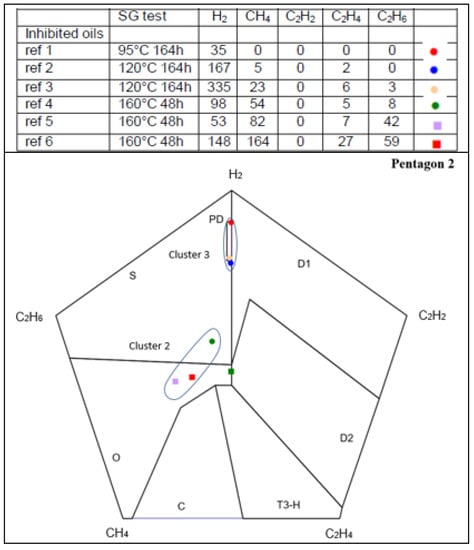
Figure 3.
SG of inhibited mineral oils other than oil A during SG tests by laboratories other than the FKH, in Clusters 3 and 2.
In Figure 4 are indicated cases of SG with high H2 formation in transformers filled with inhibited mineral oil and reported by various sources other than FKH (indicated as ref. 1 to ref. 9 in Figure 4). The PD tests made on these transformers did not detect any corona PD activity, so gas formation was due only to SG of the oil.
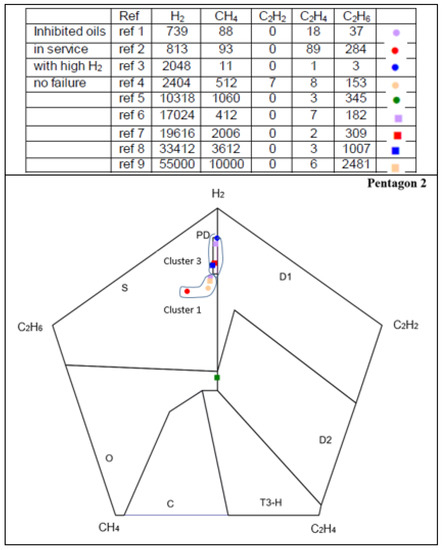
Figure 4.
SG of inhibited mineral oils other than oil A in transformers other than from the FKH, in Clusters 1 and 3.
These cases occur in Clusters 1 and 3, close to those in Figure 2 with oil A. They were therefore probably due to overheating of the oil between 105 °C and 120 °C during several years or decades, possibly in the core.
5. Stray Gassing of Uninhibited Mineral Oil B
Results of the SG laboratory tests at the FKH with uninhibited mineral oil B at 70 °C to 160 °C, with and without copper, using mostly Procedure 1 but also Procedure 2, are indicated in Figure 5.
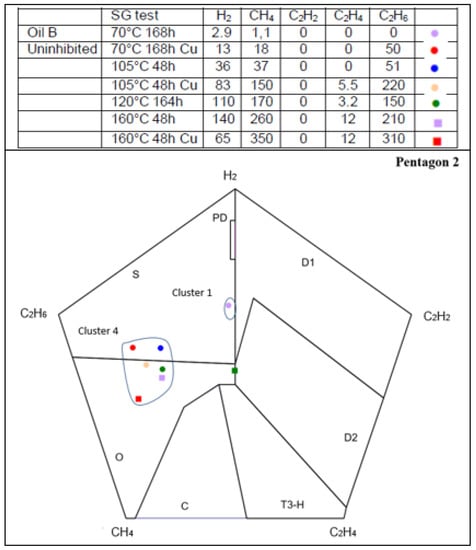
Figure 5.
SG of uninhibited mineral oil B during laboratory SG tests at the FKH, in Clusters 1 and 4.
SG occurs in Cluster 1, only at 70 °C without copper. It occurs in Cluster 4 for all other test conditions (105 °C to 160 °C, with or without copper).
From this laboratory, for the SG test results with uninhibited mineral oils, it can be concluded that the SG patterns of the uninhibited oils are similar using Procedure 1 and Procedure 2, with or without copper. However, Procedure 1 is more versatile, providing SG patterns at all temperatures and producing larger amounts of gases in ppm.
The typical SG patterns observed in the FKH transformers filled with uninhibited mineral oil B are indicated in Figure 6, listed by increasing amounts of C2H6. They tend to occur in Clusters 3 and 4, close to those during the laboratory SG tests in Figure 5.
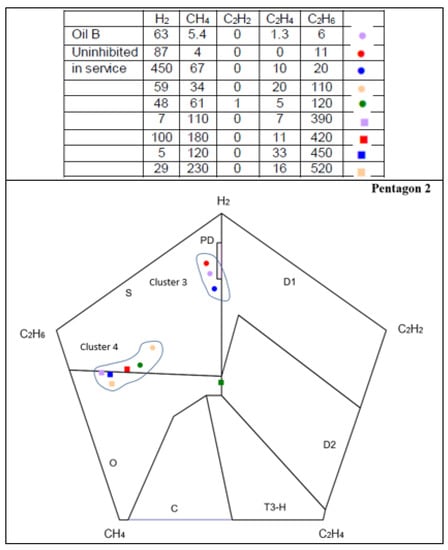
Figure 6.
SG of uninhibited mineral oil B in transformers of the FKH, in Clusters 3 and 4.
6. Stray Gassing of Other Uninhibited Mineral Oils
The results of the laboratory SG tests performed by laboratories other than the FKH (indicated as ref. 1 to ref. 5 in Figure 7) on uninhibited mineral oils other than oil B at temperatures of up to 120 °C are indicated in Figure 7. They tend to occur in Clusters 1 and 2.
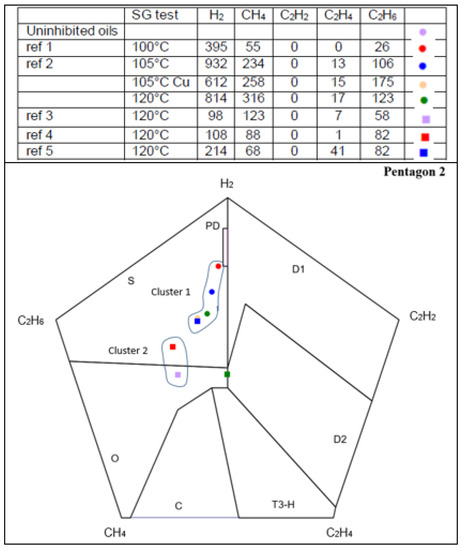
Figure 7.
SG of uninhibited mineral oils other than oil B during the SG tests (T < 120 °C) by laboratories other than the FKH, in Clusters 1 and 2.
The results of the laboratory SG tests performed by laboratories other than the FKH (indicated as ref. 6 to ref. 8 in Figure 8) on uninhibited oils other than oil B at temperatures above 140 °C are indicated in Figure 8. They tend to occur in Cluster 4.
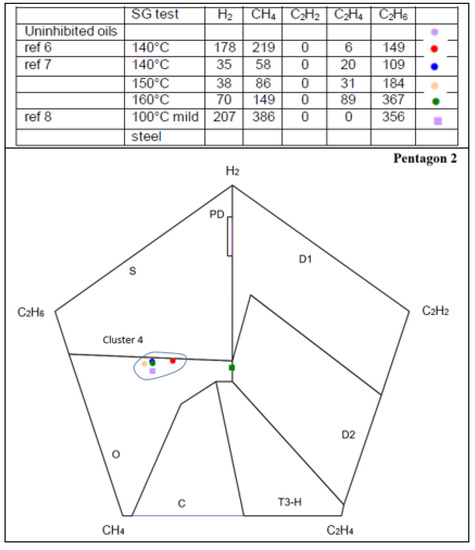
Figure 8.
SG of uninhibited mineral oils other than oil B during the SG tests (T > 140 °C) by laboratories other than the FKH, in Cluster 4.
SG formations in Clusters 1 and 2 in transformers other than from the FKH (indicated as ref. 1 to ref. 5 in Figure 9) filled with uninhibited oils other than oil B are indicated in Figure 9. They are probably due to temperatures <120 °C in the transformers.
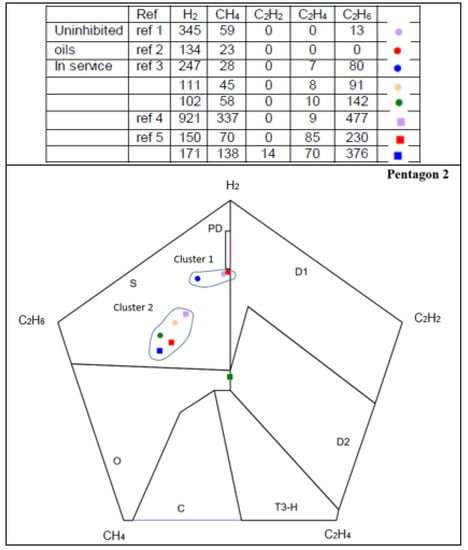
Figure 9.
SG of uninhibited mineral oils other than oil B in transformers other than those from the FKH, in Clusters 1 and 2.
SG formations in Cluster 4 in transformers other than from the FKH (indicated as ref. 5 to ref. 7 in Figure 10) filled with uninhibited oils other than oil B are indicated in Figure 10. They are probably due to temperatures >140 °C in the transformers.
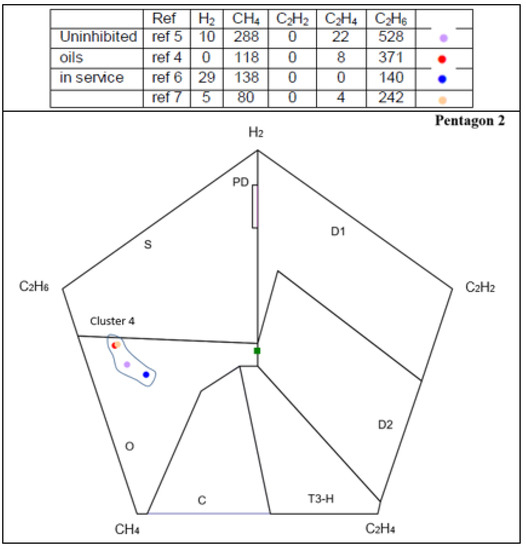
Figure 10.
SG of uninhibited mineral oils other than oil B in transformers other than those from the FKH, in Cluster 4.
7. Conclusions
(1) The SG patterns of the inhibited and uninhibited mineral oils during the laboratory tests and in the transformers have been identified and compared in this paper using Duval Pentagon 2.
(2) There is a good correlation between SG in the transformers and SG in the laboratory tests performed at one or several temperatures on samples of the oil used in the transformers. SG in transformers can thus easily be differentiated from other possible faults, such as corona PD and thermal faults of higher temperatures.
(3) SG patterns during laboratory tests allow to evaluate the approximate temperature of overheating of the oil in the transformers, between 70 °C and 160 °C.
(4) The stray gassing (SG) procedure of CIGRE TB 296-2006 [3] is much more appropriate for identifying the SG patterns of inhibited mineral oils than the new procedure of IEC 60296-2020 [6], which produce much smaller, insignificant amounts of SG gases. It is also much more versatile for uninhibited mineral oils, providing SG patterns at all temperatures.
(5) Once SG of the oil has been identified in a transformer, it has been shown in [4] that it does not affect the normal operation of the transformer, even when very large amounts of SG gases are formed (see Figure 4). The mandatory limits of SG for new mineral insulating oils in IEC 60296-2020 are therefore unneeded and irrelevant.
Author Contributions
Conceptualization, M.D.; methodology, M.D.; validation, M.D. and T.H.; formal analysis, M.D.; investigation, M.D.; resources, T.H.; data curation, M.D. and T.H.; writing—original draft preparation, M.D.; writing—review and editing, M.D. and T.H. All authors have read and agreed to the published version of the manuscript.
Funding
This research received no external funding.
Conflicts of Interest
The authors declare no conflict of interest.
References
- Pahlavanpour, B.; IEC TC10 Chairman, Nynas, UK. Private communication, 2020.
- Koch, M.; Heizmann, T. Experiences with application, diagnostic value and impact on asset management of insulation oil analysis. In Proceedings of the 19th International Symposium on High Voltage Engineering, Pilsen, Czech Republic, 23–28 August 2015. [Google Scholar]
- CIGRE D1-01/A2.11. Recent Developments in DGA Interpretation; CIGRE Technical Brochure # 296; Convenor, M. Duval; CIGRE: Paris, France, June 2006. [Google Scholar]
- CIGRE D1/A2.47. Advances in DGA Interpretation; CIGRE Technical Brochure # 771; Convenor M. Duval; CIGRE: Paris, France, July 2019. [Google Scholar]
- Guide for the Interpretation of Gases Generated in Mineral Oil-Immersed Transformers; IEEE Standard C57.104; IEEE Power and Energy Society: Piscataway, NJ, USA, 2019.
- Standard Rest Method for the Determination of Gassing Characteristics of Insulating Liquids under Thermal Stress; ASTM Method D 7150-13; ASTM: West Conshohocken, PA, USA, 2014.
- Fluids for Electrotechnical Applications. Mineral Insulating Oils for Electrical Insulation; IEC Standard 60296; International Electrotechnical Commission: Geneva, Switzerland, June 2020.
- Duval, M. Use of duval pentagons and triangles for the interpretation of DGA in electrical equipment. In Proceedings of the TechCon North America Conference, Albuquerque, NM, USA, 23 February 2016. [Google Scholar]
© 2020 by the authors. Licensee MDPI, Basel, Switzerland. This article is an open access article distributed under the terms and conditions of the Creative Commons Attribution (CC BY) license (http://creativecommons.org/licenses/by/4.0/).